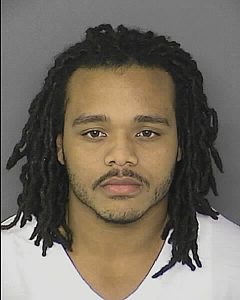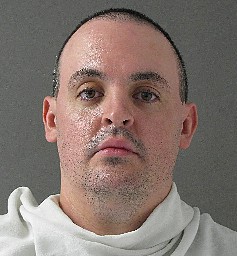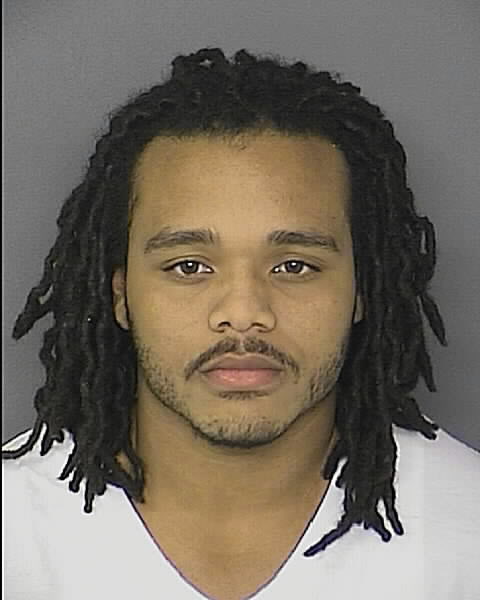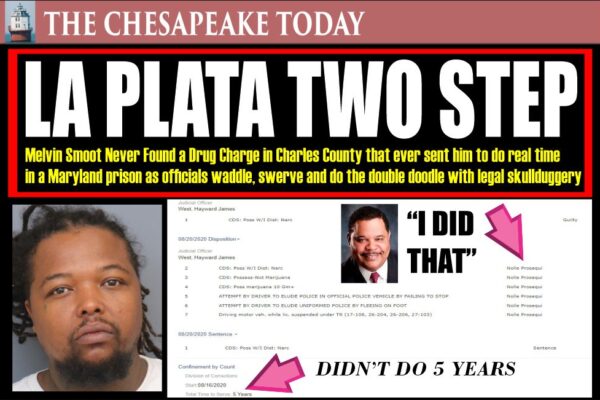
Don’t miss: LITTLE WHITE LIES Starring Cameron’s Commanders
WHEN A LIAR COP CAN’T TESTIFY IN A CRIMINAL CASE; BAD GUYS MAY BE RELEASED
The case of the Deceptive Detective Capt. Dan Alioto


When a key investigator involved in Maryland and Federal narcotics investigations suddenly quit while under investigation by the St. Mary’s Sheriff’s Department for three factors: truthfulness, failure to cooperate with an investigation, and illegal instructions to subordinate officers, there may be complete turmoil as a result.
St. Mary’s Sheriff Tim Cameron’s top vice squad commander since 2006, Captain Daniel Alioto, suddenly resigned last year when confronted with evidence that revealed he allegedly lied in an investigation. Alioto has directed dozens of drug distribution cases since 2006, and his testimony and command of the critical criminal section of the St. Mary’s Sheriff’s Department may leave dozens of cases in jeopardy and even the release of convicted drug dealers.
THE CHESAPEAKE TODAY requested more information on Alioto’s sudden departure 2017 from Sheriff Cameron.
The following is a case of a criminal investigation and conviction in which Alioto has been involved:

Tyreke Delante Butler; convicted in St. Mary’s County Circuit Court of attempted first-degree murder; possession of a firearm by a felon; solicit/conspire to induce testimony in a felony case; use of a firearm in a violent crime, on August 30, 2016, sentenced to 50 years in prison. On Wednesday, October 14th, 2015, Detectives from the St. Mary’s County Sheriff’s Criminal Investigations Division extradited Tyreke Delante Butler with the assistance of the Maryland State Police Aviation Division and the Fulton County, Georgia Sheriff’s Office. Butler was returned to Maryland and served a Grand Jury Indictment for the attempted murder which occurred on September 11, 2015.
On September 24, 2015, Tyreke Delante Butler of Lexington Park, was taken into custody without incident in Atlanta Georgia by members of the US Marshal Capital Area Regional Fugitive Task Force and the South Eastern Regional Fugitive Task Force. Butler was wanted by the St. Mary’s County Sheriff’s Office on an open arrest warrant charging him with Attempted First-Degree Murder following a shooting on September 11, 2015, in Lexington Park.
The decision of the Court of Special Appeals resulted in the court upholding the conviction of a dangerous and violent offender who tried to kill his drug-dealing compatriot.
In 2016, a jury in the Circuit Court for St. Mary’s County convicted Tyreke D. Butler, appellant, of attempted first-degree murder, first-degree assault, use of a firearm in the commission of a felony, felon in possession of a firearm, prohibited person in possession of a firearm, conspiracy to commit first-degree assault, and conspiracy to induce a witness to testify falsely. He was acquitted of conspiracy to commit first-degree assault. On August 30, 2016, appellant was sentenced to a total term of fifty years’ imprisonment. On appeal, appellant raises two issues for our review, which we have rephrased slightly:1
Did the circuit court properly deny appellant’s motion to suppress an eyewitness identification where the police used an impermissibly suggestive single photograph identification procedure?
Was the evidence presented sufficient to sustain the appellant’s convictions?
For the following reasons, we answer the questions above in the affirmative and affirm the judgments of the circuit court.
Appellant asked the following questions:
Did the court below err by failing to suppress the unreliable identification of Mr. Butler by a witness after the police used an impermissibly suggestive single photograph identification procedure?
Was the evidence insufficient to convict Mr. Butler of any crime?
BACKGROUND
This case stems from the September 11, 2015, shooting of Robert Blake, who was found in a wooded area in Lexington Park after having sustained approximately ten gunshot wounds. Blake identified appellant as the gunman to responding officers immediately after the shooting occurred, and again in court, and stated that he was shot in retaliation for stealing drugs from appellant. The defense claimed that appellant was not the gunman, emphasized the State’s failure to present any physical evidence linking appellant to the crime scene, and introduced an alibi witness who testified that appellant was watching television at his house at the time the shooting occurred.

The evidence adduced at trial reflects that Blake spent the day before the incident “hanging out” with appellant, a person he considered a friend and from whom he had purchased drugs for many years. Blake used drugs throughout the day, and the two men returned to the home appellant shared with his girlfriend late that night. In the early morning hours of September 11, 2015, Blake took several Xanax pills from appellant while he slept. He then left the house and walked to the methadone clinic, where he encountered Jason Reintzell. Blake asked Reintzell for a ride and asked him to help sell the stolen pills so that they could earn money to buy cocaine.
As Reintzell drove around town contacting potential customers, Blake borrowed one of Reintzell’s phones and used it to contact appellant. Traevon Butler, Reintzell’s drug dealer, and appellant’s brother called Reintzell and told him that he knew that Blake was with him, and then instructed Reintzell to contact appellant. Reintzell retrieved his phone from Blake and sent a text message to the number Blake had called. A man that Reintzell assumed to be appellant called him back on his other phone, and they agreed to meet at Cadillac Jacks, a bar. Reintzell did not tell Blake that he was taking him to meet appellant.

Within seconds of Reintzell and Blake’s arrival, a Jeep Cherokee drove into the parking lot of Cadillac Jacks and parked next to them. The driver exited the truck and knocked on the passenger side window of Reintzell’s car with something “loud” that sounded like “a metal object.” Blake, who was sleeping, was awakened by the knock on the window and saw appellant standing next to the car. According to Reintzell, when Blake rolled down the window, appellant told him “you better have my shit and my money, get out of the car.” Blake exited Reintzell’s vehicle and got in the passenger seat of the Jeep. Reintzell said that he tried to return the stolen Xanax, however, appellant told him to keep the pills, handed him $100, and then warned him to “keep [his] mouth shut.” Reintzell, who testified that he had never met appellant before, identified appellant as the person who left Cadillac Jack’s with Blake, noting that he made eye contact with him over the hood of his car.
Blake testified that once they were inside the Jeep, appellant punched him, chipping his tooth, breaking his nose, and knocking him unconscious. His next recollection was being awakened by a bullet hitting his head, and he asked appellant to stop shooting as he watched him reload the gun. Appellant shot Blake five more times before Blake noticed another car, at which point he began to scream for help. Appellant then fled in his Jeep.
Charlie Stamm testified that as she was driving on Far Cry Road, she saw someone dragging “something” into the woods, and, as she approached, she heard a man repeatedly screaming “please don’t kill me.” Ms. Stamm said that she was between 30 and 40 feet from the men during the incident, and she got “a very good look” at both
Blake and the “average height,” “muscular” “black man with shoulder length or just past dreadlocks” who was dragging him. Ms. Stamm identified the appellant in court as the person that she saw in the woods, but she was not “100 percent sure” because although “[h]is eyes are very similar[,] [h]is face is the same shape[,] [h]is build is very similar[,]” “when I saw him, his nostrils were flared up and his face was very distorted.” Ms.
Stamm said that she stared into the man’s eyes as she backed her car up the road, and that appellant “has the same eyes that I stared into.” She then watched the man leave in a silver Jeep Cherokee with an obscured license plate.
Ms. Stamm called 911, and at approximately 11:15 a.m., St. Mary’s County Sheriff’s deputies responded to Far Cry Road, where they found Blake laying on the ground covered in blood. Deputy Taylore Siciliano testified that medical assessment revealed what appeared to be multiple gunshot wounds and that she recovered a bullet from his clothing. Blake, who was “conscious and aware,” told deputies his name and that appellant had shot him. Deputy Dustin McClure, who accompanied Blake to the hospital, testified that once he was stable, Blake told him that appellant had picked him up from Cadillac Jack’s, driven him to Far Cry Road, and then shot him.
The area where Blake was found was secured and crime scene technicians recovered his blood-soaked shirt and a pair of bloody shoes. Investigators showed Ms. Stamm a photo array within a few hours of the incident, and she was unable to identify appellant as a suspect. She told investigators that the photograph of a man, who was not appellant, had a nose similar to the man that she saw, but that none of the photographs looked exactly like the suspect.
Deputies also interviewed two witnesses who said that they heard 10 gunshots fired around 10:30 a.m. Lead detective Corporal Cory Ellis testified that there was no physical evidence, including DNA or a firearm, that connected appellant to the crime scene. On September 27, 2015, appellant’s Jeep was recovered by police in St. Inigoes, and a search revealed no physical evidence related to the shooting.
The State introduced verified business records for several mobile phones, including a Verizon account attributed to appellant. Blake’s mother testified that she had several missed calls from appellant’s phone the morning he was shot, and that when she returned the calls, he asked her whether her son was with her. She also said that when her son did not contact her during the day as usual, she called and texted appellant’s number. The State introduced records of a 2:54 p.m. text message to appellant’s phone which read “[h]ey this is bobby’s mom, have you seen him today” and a 7:55 p.m. text message which read “I’m sorry to bother you, but by chance have you heard or seen bobby.” Appellant’s mother testified that she knew his telephone number well and was not familiar with the number attributed to him by the State, however, on cross-examination, the State presented evidence that the number she knew for her son had called the number the State attributed to his phone.
Corporal Robert Merritt, an expert in historical cell communications, location, and mapping for the St. Mary’s County Sheriff’s office, mapped the data for appellant’s phone on the morning Blake was shot. He testified that the phone connected to a cell-site near Cadillac Jacks at 10:30 a.m. and connected to a site near the crime scene at 11:09 a.m. The data indicated that the phone was traveling away from Far Cry Road at 11:13 a.m. before it went inactive at 12:38 p.m.
Blake identified appellant in court as the person who had shot him. Defense counsel cross-examined him at length concerning an affidavit he had signed recanting his identification of appellant and declaring that another man was the gunman. Blake said that appellant’s brother surprised him coming home, told him to get in a car with “two guys beside me and two in the front of me,” and then drove him to meet appellant’s lawyer. He testified that he “would have signed anything they had written on this paper” because he was “scared” and was “just hoping not to go through what I went through again . . . after what I’ve been through, would you sign a paper if this man’s brother that shot me is right next to me.” He admitted, however, that he continued to contact appellant’s brother to purchase drugs despite his testimony that he was afraid of him. As to his status as a confidential informant for the police, Blake acknowledged that he had been provided food, hotel stays, and money that he used to buy drugs in exchange for conducting controlled drug buys.
Additional facts will be included as they become relevant to our discussion, below.
DISCUSSION
Witness Identification
Appellant filed a pretrial motion to suppress Reintzell’s identification testimony, arguing that the police used an impermissibly suggestive single photograph identification procedure. Reintzell failed to appear at the June 10, 2016 motions hearing, consequently, the circuit court issued a material witness warrant to compel him to testify at trial. The court then heard the suppression motion on June 21, 2016, the first day of trial. After hearing testimony from Reintzell, the audio recording from the September 12, 2015 police interview where he was first shown appellant’s photograph, and the audio recording from his June 16, 2016 interview with an investigator about the case, the court determined that although the identification procedure was impermissibly suggestive, however, it was unlikely to lead to a substantial likelihood of irreparable misidentification.
Appellant argued before this Court that the circuit court erred in concluding that Reintzell’s identification was reliable and denying the motion to suppress. The State conceded that the use of a single photograph was unduly suggestive but argued that the circuit court rightly concluded that Reintzell’s identification was sufficiently reliable to overcome the impermissibly suggestive pre-trial identification procedure. The State further maintained that any error in the denial of the motion to suppress was harmless “because the victim made unequivocal pre-trial and in-court identifications” of the appellant.
We agree with the State.
Appellate courts reviewing the disposition of a motion to suppress “‘look only to the record of the suppression hearing and do not consider the evidence admitted at trial.’” James v. State, 191 Md. App. 233, 251 (2010) (quoting Massey v. State, 173 Md. App. 94, 100-01 (2007) (citations omitted)). We accept the factual findings and credibility determinations of the suppression court unless they are clearly erroneous, and we review the evidence and inferences reasonably drawn therefrom in the light most favorable to the prevailing party, in this case, the State. Wallace v. State, 219 Md. App. 234, 243 (2014) (citation omitted). We review de novo the constitutionality of the identification procedure, however, applying the relevant law to the facts. In re Matthew S., 199 Md. App. 436, 447 (2011) (citing Gatewood v. State, 158 Md. App. 458, 475-76 (2004), aff’d on other grounds, 388 Md. 526 (2005)).
“With respect to identification testimony, courts have recognized that ‘[d]ue process protects the accused against the introduction of evidence of, or tainted by, unreliable pretrial identifications obtained through unnecessarily suggestive procedures.’” James, 191 Md. App. at 251-52 (quoting Webster v. State, 299 Md. 581, 599-600 (1984) (citations omitted)). “Due process principles apply to remedy the unfairness that would result from the admission of evidence that is based on an identification procedure that was ‘unnecessarily suggestive’ and conducive to misidentification at trial.” Id. at 252.
Maryland courts apply a two-step inquiry to determine whether an extrajudicial identification is inadmissible on due process grounds:
“The first question is whether the identification procedure was impermissibly suggestive.” If the procedure is not impermissibly suggestive, then the inquiry ends. If, however, the procedure is determined to be impermissibly suggestive, then the second step is triggered, and the court must determine “whether, under the totality of circumstances, the identification was reliable.” If a prima facie showing is made that the identification was impermissibly suggestive, then the burden shifts to the State to show, under a totality of circumstances, that it was reliable.
Smiley v. State, 442 Md. 168, 180 (2015) (citations omitted). The defendant bears the initial burden of demonstrating that the identification procedure was unduly suggestive, and if this burden is met, then the burden shifts to the State to prove that the identification is reliable. Upshur v. State, 208 Md. App. 383, 400-01 (2012) (citing In re Matthew S.,
199 Md. App. at 436, 447-48 (2011)). Courts consider the following factors to determine whether an impermissibly suggestive identification was reliable:
[T]he opportunity of the witness to view the criminal at the time of the
crime, the witness’ degree of attention, the accuracy of the witness’ prior description of the criminal, the level of certainty demonstrated by the witness at the confrontation, and the length of time between the crime and the confrontation.
Id. at 401 (quoting Neil v. Biggers, 409 U.S. 188, 199-200 (1972)).
In this case, Reintzell testified that he had ingested crack cocaine and Xanax before the meeting at Cadillac Jacks. When asked whether his drug use that morning may have affected his memory, he denied any impact, explaining that “I take Xanax as a prescription anyways, so like I just had like a little buzz,” and that he had taken the Xanax to “calm down” from his high. The encounter occurred in the morning for
approximately two minutes, and Reintzell said that he was “three and a half feet, four feet” from appellant on the other side of his car.
In the audio recording of his interview with investigating officers the day after the shooting, Reintzell described the suspect as a “black guy,” “younger,” and “kind of heavy,” with his hair in “dreads.” He also said that the man pulled into the parking lot driving a Jeep Cherokee. When asked if he would recognize the man if he saw a picture of him, Reintzell said that he probably would.
Reintzell was then asked to look at a photograph of “the guy who we think it is” and was shown a single photograph of appellant. In the audio recording, officers described Reintzell as becoming “extremely emotional” when shown appellant’s photograph and then exiting the vehicle where they were conducting the interview. Reintzell testified at the suppression hearing, however, that he did not confirm that appellant was the suspect during the interview because he was trying not to get involved and had received threats.
The audio recording from Reintzell’s second interview with detectives reflects that he described the man who met him at Cadillac Jacks as having “light skin,” “long braids,” who drove a “light color” Jeep Cherokee that was either brown or tan. During the suppression hearing, when asked whether the person in the photographs that detectives showed him on September 12, 2015, was the same person he met at Cadillac Jacks the day Blake was shot, Reintzell testified “Yeah, I knew it was and I knew what had happened to Blake and I was just like, all I was thinking about was like my son and my son’s safety and my own.” Reintzell then made an in-court identification of appellant, stating “I’m positive that’s him.”
The circuit court concluded that the defense had carried its burden, noting that “one picture shown to a witness without exigent circumstances is impermissibly suggestive.” The court then noted that Reintzell had observed appellant during daylight hours for approximately two minutes, and that the length of time between the shooting and the initial confrontation was one day. As to the accuracy of the prior description, Reintzell had described the suspect as “light-skinned” “with his hair down and in braids” during the police interview before officers showed him appellant’s photograph. Although Reintzell had incorrectly described the color of appellant’s vehicle as “brown, brownish,” the court noted that he had accurately identified it as a Jeep Cherokee. The court also addressed the effects of Reintzell’s drug use on his memory of the event, noting that Reintzell said he “had a little buzz” and had last used one or two hours before the meeting.
Further, the circuit court observed that there was “strong” “almost self-authenticating” circumstantial evidence that appellant was the person Reintzell saw, because the meeting was arranged at the urging of appellant’s brother, Traevon, a person Reintzell knew well. Reintzell spoke on the phone with a man he understood to be
Traevon’s brother to arrange the meeting, a man arrived moments after he reached the designated meeting location, and when he asked Blake if he was okay leaving with this individual, Blake told him “this is my homie.”
Finally, the court emphasized that Reintzell had “no question whatsoever” that appellant was the person that he saw in the parking lot of Cadillac Jacks. Based on “the time he had, his degree of attention, his opportunity to view the criminal at the time of the crime, the accuracy of the witness’ prior description of the criminal, the level of certainty demonstrated by the witness at the confrontation and the length of time between the crime and the confrontation,” the court ruled that the identification was reliable and denied the motion to suppress.
We are not persuaded that the circuit court erred in denying the motion. Appellant analogized the facts in this case to Rustin v. State, 46 Md. App. 28 (1980), and urged us to conclude that Reintzell’s identification was not reliable because he was intoxicated on the morning of the shooting, had no reason to believe a crime would be committed, his description lacked detail, and the interaction only lasted two minutes.
In Rustin, a police detective responded to an armed robbery and arrested the defendant’s brother within hours of the incident based on his own recollection of the suspect, then arrested Rustin two months later after several sources told the detective that he had apprehended the wrong person. Id. at 30-31. Responding to this information, the detective looked at a single photograph of Rustin, reviewed his criminal history, and spent approximately two hours with him one-on-one. Id. We reversed Rustin’s convictions, concluding that the positive factors of reliability did not outweigh the suggestiveness of the pretrial identification procedure. Id. at 33.
The facts in Rustin are distinguishable from the instant case. First, the detective in Rustin viewed the suspect for five to ten seconds, at night, under street and store lights after responding to a report of a crime in progress. Id. at 34. Here, Reintzell observed appellant for two minutes, in daylight, from three or four feet away. Moreover, Reintzell interacted directly with appellant, who gave him pills and money before warning him to not talk about what he had seen. Further, the detective in Rustin was unexpectedly called to the scene and did not know he would be required to identify armed robbery suspects later. Id. Although Reintzell may not have realized that Blake would be assaulted and nearly killed when he left with appellant, unlike the detective in Rustin, he planned the meeting with his drug dealer’s brother to return the pills that Blake had stolen.
Appellant also argued that Reintzell’s description lacked detail and specifically cites his inability to describe the clothing the suspect was wearing. However, the day after the incident, Reintzell told officers that he saw a younger-looking black male with a “heavy” build and dreads before he was shown appellant’s photograph.
Appellant overlooked the inclusion of the suspect’s vehicle, a Jeep Cherokee, in Reintzell’s description, a detail that he could not have discerned from the photograph. Finally, as to the certainty of the identification, the officer in Rustin initially arrested the defendant’s brother and then later testified that he was not certain that the defendant was the perpetrator. Id. at 34. Reintzell, however, testified that he was “positive” that appellant was the man who left the parking lot of Cadillac Jack’s with Blake. Accordingly, we affirm the circuit court’s ruling that, although the single photograph identification procedure was impermissibly suggestive, the State satisfied its burden to prove that Reintzell’s identification was reliable.
Sufficiency of the Evidence
Appellant contended that the evidence was insufficient to convict him of any of the crimes for which he was charged. Specifically, he argues that since Blake did not attest to any specific threats or harm done to him, the State did not demonstrate that he was induced to testify falsely. He further asserted that evidence of his brother’s involvement in transporting Blake to sign the affidavit does not prove the existence of a conspiracy involving him. The State responded that there was sufficient evidence to sustain the convictions. We agree with the State.
This Court, in reviewing a challenge to the sufficiency of the evidence, applies the standard of “‘whether, after viewing the evidence in the light most favorable to the prosecution, any rational trier of fact could have found the essential elements of the crime beyond a reasonable doubt.’” McClurkin v. State, 222 Md. App. 461, 486 (citing Moye v. State, 369 Md. 2, 12-13 (2002)). We give “due regard to the [fact-finder’s] findings of facts, its resolution of conflicting evidence, and, significantly, its opportunity to observe and assess the credibility of witnesses.” Harrison v. State, 382 Md. 477, 487-88 (2004)
(citing McDonald v. State, 347 Md. 452, 474 (1997) (quoting State v. Albrecht, 336 Md. 475, 478 (1994)). In performing its function, “the jury [is] free to accept the evidence it believes and reject that which it does not.” Muir v. State, 64 Md. App. 648, 654 (1985), cert. granted, 305 Md. 244 (1986), aff’d, 308 Md. 208 (1986). Accordingly, “[t]he test is ‘not whether the evidence should have or probably would have persuaded the majority of fact finders but only whether it possibly could have persuaded any rational fact finder.’” Painter v. State, 157 Md. App. 1, 11 (2004) (emphasis in original) (citing Mora v. State, 123 Md. App. 699, 727 (1998)).
To support a conviction for common law conspiracy, the evidence introduced by the State must show “the combination of two or more persons to accomplish some
unlawful purpose, or to accomplish a lawful purpose by unlawful means. The essence of a criminal conspiracy is an unlawful agreement.” Mitchell v. State, 363 Md. 130, 145 (2001). The Court in Mitchell explained that “[t]he agreement need not be formal or spoken, provided there is a meeting of the minds reflecting a unity of purpose and design.”
Id. To meet its burden of proof, “‘the State [is] only required to present facts that would allow the jury to infer that the parties entered into an unlawful agreement.’” Darling v. State, 232 Md. App. 430, 467 (2017) (citation omitted)). The State alleged that appellant conspired to induce false testimony in violation of Md. Code (2002, 2012 Repl. Vol.), § 9-302(a) of the Criminal Law Article, which provides in relevant part that “[a] person may not . . . threaten to harm another . . . with the intent to: (1) influence a victim or witness to testify falsely or withhold testimony; or (2) induce a victim or witness: . . . (iii) not to report the existence of facts relating to a crime or delinquent act.”
Appellant, relying on Saunders v. State, 28 Md. App. 455 (1975), contended that the mere fact of a familial relationship is not sufficient evidence to clearly show his connection to a conspiracy to induce false testimony. In Saunders, however, this Court explained that “authorization by the accused may be proved by direct or circumstantial evidence” and that “an inference may be sufficient to connect the accused.” Id. at 460 (internal citations omitted). Here, a reasonable jury could have found that appellant and his brother engaged in a pattern of illegal activity from which a conspiracy to induce
Blake to testify falsely could be inferred. It was through Traevon’s efforts in contacting Reintzell on his behalf that appellant was able to locate Blake on the morning he was shot. Once appellant had secured Blake, he bribed Reintzell with drugs and money to
“keep [his] mouth shut.” Reintzell testified that two days after the shooting, Traevon arranged a meeting with him, where a man in the back seat touched his neck with an object that he assumed was a gun, and Traevon, who had placed a gun on his lap, threatened Reintzell, and then made him speak with appellant on the phone, who told him “he paid me the pills and the money, that I would be charged with accessory of attempted murder so I had to keep my mouth shut.” Reintzell also testified that after the incident in the car, he was badly beaten by a group of masked men for being a “snitch,” and that he
could recognize Traevon’s voice among the group.
Blake testified that on the day he signed the affidavits, Traevon had “caught” him outside of his house, and that he had “a group of guys” in his car. He said that “after what I went through . . . I was just scared . . . a group of them and the fact that he’s
[appellant’s brother].” A rational juror could, on this basis, draw a reasonable inference that based on the pattern of violent encounters recounted by Reintzell and Blake, that
Traevon’s unannounced visit to Blake’s home with a group of men he did not know was intended to intimidate him, and that Blake was induced to sign the affidavit recanting his earlier identification in response to the implied threat of harm. Moreover, although appellant may not have been present when his brother ambushed Blake and took him to meet with his lawyer, a rational juror could infer that appellant authorized his brother’s actions based on the evidence of their combined efforts to silence Reintzell through bribes, threats, and violence.
As to the remaining charges, appellant contends that because investigators failed to recover the gun or any physical evidence which tied him to the crime scene, especially blood in his truck to corroborate Blake’s testimony that he was punched hard enough to break his nose, that the evidence was insufficient to convict him. Appellant’s contention erroneously assumes that the State was required to present physical evidence, whether the gun or otherwise, to prove the elements of the crimes for which he was convicted. See Corbin v. State, 428 Md. 488, 514 (2012) (holding that circumstantial evidence is sufficient to sustain a conviction).
The testimony of one individual, if believed by the fact-finder, is sufficient to support a conviction, and here, Blake testified that appellant was the person who shot him. Although corroboration is not legally required, Ms. Stamm corroborated his testimony when she testified that she saw a muscular black male with dreadlocks dragging Blake through the woods off Far Cry Road, and that the man left the scene in a silver Jeep Cherokee. Further, the State introduced evidence that a cell phone belonging
to appellant was in the area near Cadillac Jacks around the time that Blake was picked up and near Far Cry Road when he was shot and nearly killed.
Viewing the evidence in the light most favorable to the prosecution and according deference to the findings of the jury, we conclude that the evidence provided a sufficient basis from which a reasonable jury could conclude that appellant was the gunman.
Accordingly, we affirm appellant’s convictions.
JUDGMENTS OF THE CIRCUIT COURT FOR ST. MARY’S COUNTY AFFIRMED. COSTS TO BE PAID BY APPELLANT
Discover more from THE CHESAPEAKE TODAY - ALL CRIME, ALL THE TIME
Subscribe to get the latest posts sent to your email.
















When ain’t they lieing..all the cops